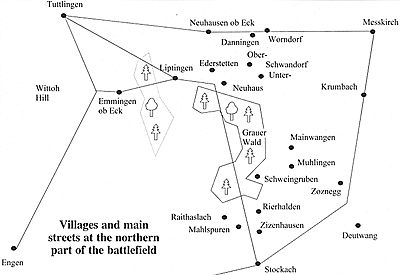Battle of Stockach
25 March 1799
Part 1
Charles' and Jourdan's Plans
by Roland Kessinger, Germany
| |
During the evening of the 24th, Charles had been informed by FML Nauendorf that the French army was mostly concentrated around Engen -- this was essentially correct as three of Jourdan’s five Divisions were there. Charles would also have known that Jourdan was numerically inferior. From the outset of the campaign, the French commander had only moved cautiously and rather slowly, so no French attack was expected. However, it was clear that that Jourdan had not continued his retreat on the 24th. Archduke Charles’ strategic target was Switzerland, but before he could fall into the rear of Massena’s Army of Helvetia, he would have to evict Jourdan from Germany. The Archduke therefore planned a limited attack for the following day. Merveldt’s advance guard, reinforced with Kempf’s infantry brigade was to advance to Tuttlingen to separate St. Cyr and Vandamme from the rest of the French army. At the same time, FML Nauendorf, whose advance guard brigades under GMs Gyulai and Kienmayer had been reinforced by IR2 Erzherzog Ferdinand together with 11. Latour and 12. Kinsky Light Dragoons, was to push forward to Engen to reconnoitre the French positions around there. Once St. Cyr was cut off, Jourdan would be in danger of being outflanked by a superior force, effectively forcing him to continue his retreat through the Black Forest to the Rhine. Once Jourdan was back on the far bank, Charles could prosecute the main part of his plan: crossing the upper Rhine near Lake Constance and invading Switzerland. Jourdan’s Plans for the Battle The French commander in his headquarters at Engen during the evening of March 24 th had other ideas. He had received reports that St. Cyr had been attacked by large numbers of Austrian troops. Jourdan had not been aggressive during this campaign - he had adopted a defensive position along the Ostrach-Rotach line on March 20 th and then waited for Charles. After his defeat there and heavily outnumbered, he was driven back westwards and had retreated quickly for three days before stopping. A continued retreat would probably have been wisest, but Jourdan had now decided to fight in a defensively poor position. His troops were now widely spread in a semi-circle from Lake Constance to the Danube, so he could only expect to hold this line by going over to the offensive. Many sources claim Jourdan may have halted and allowed his men to rest as he didn’t want to go back to France without mounting a single attack to avoid being punished for cowardice, but this seems unlikely as the Directory had given up guillotining unsuccessful Generals. To the south, Massena had attacked the Austrian entrenchment around Feldkirch again over March 22 nd /23 rd, but was driven off for a second time. Informed about this setback (and possibly in receipt of a letter from Massena requesting reinforcement) Jourdan knew all he could do was to attack to try to prevent the Austrians from sending more reinforcements to Feldkirch. Nevertheless, faulty intelligene seems to have been the key factor in Jourdan’s decision. Jourdan appears to have been informed, at least partly by his divisional commanders, that Charles had sent large reinforcements south, which fitted with the French assessment of Austrian intentions. Further advances by Massena would threaten the vital Tyrol passes connecting Germany with Italy. If Charles was despatching reinforcements, then a surprise French attack could further weaken the Austrians and reverse the result of Ostrach. Unfortunately for Jourdan, the Austrians had indeed sent reinforcements to the Tyrol, but they were drawn from reserve forces to the east. So, Charles’ army was undiminished aside from its losses at Ostrach. Jourdan now planned a battle for the following day, believing the forces would be equal. The whole French army would attack the Austrians in the early morning with the weight of the attack on the French left. Around Liptingen and Neuhausen ob Eck, the three Divisions of St. Cyr, Soult and d’Hautpoul (reserve) and the "Flanquers de Gauche" would advance. After the Austrians had been driven back, only Soult would pursue them, while St. Cyr and Vandamme marched towards Messkirch and on to Pfullendorf to get into the rear of the Austrian army. To the front, Ferino’s 1 st Division would advance from Singen to Nenzingen, where he would join Souham’s 2 nd Division, which had pushed forward to there from Engen via Aach. When the two divisions had joined up, Ferino would take command and march towards Stockach to push the Austrians back on Pfullendorf, so that the Austrians would be virtually encircled. In reality, Charles still had 60.000 men available while his own army was less than 40.000 strong. The outcome of that battle was more or less clear from the beginning, but would be a very hard struggle before it was decided. More Battle of Stockach: Part 1 25 March 1799
March 22nd and March 23rd March 24th -- First Clashes March 24th -- Evening Situation Charles' and Jourdan's Plans March 25th First Clashes First Austrian Counterattack Battle of Stockach: Part 2 25 March 1799
Destruction of 8e Demi-Brigade and the Austrian Pursuit Comments on the Battle Orders of Battle Back to Table of Contents -- First Empire #67 Back to First Empire List of Issues Back to MagWeb Master Magazine List © Copyright 2002 by First Empire. This article appears in MagWeb (Magazine Web) on the Internet World Wide Web. Other military history articles and gaming articles are available at http://www.magweb.com |

 Charles’ Plans
Charles’ Plans